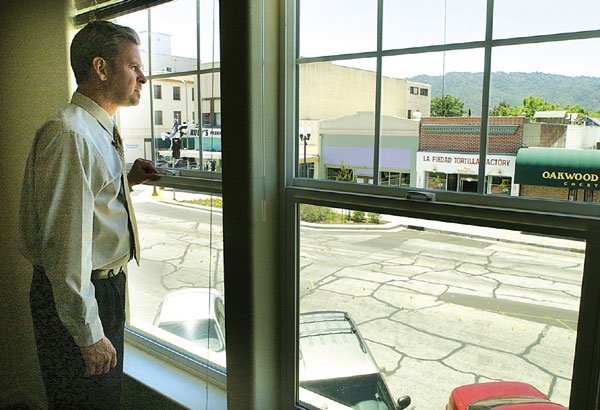Gilroy
– Affordable housing – and its absence in Gilroy – has drawn a
great deal of attention in recent months. As housing proposals
weave through the approval process, city leaders have complained
that many young professionals simply cannot afford to live in a
city where home prices have soared ab
ove $600,000.
Gilroy – Affordable housing – and its absence in Gilroy – has drawn a great deal of attention in recent months. As housing proposals weave through the approval process, city leaders have complained that many young professionals simply cannot afford to live in a city where home prices have soared above $600,000. But in many ways, the affordable housing debate has overshadowed the less sexy but equally important issue of urban growth.
That trend will continue for the moment, as City Council has put off making a decision about a crucial theme in the debate until 2006. By then, councilmen hope to have in their hands several area-specific planning guidelines that will play a vital role in charting the city’s growth.
Planners across the country grapple with the same basic problem: how to keep residential growth in step with a city’s ability to provide services.
In 2001, Gilroy officials thought they had found an answer to the growth question, as well as a decent fix to the affordable housing problem.
The solution: reduce the city’s 10-year growth limit from 4,000 homes, to 3,450, and include incentives for affordable housing.
The number represents the total number of housing units for which the city would grant construction permits between 2004 and 2013. Why is the number important?
“We use the number for planning,” said City Councilman Craig Gartman, who served on the Planning Commission when City Council set the growth figure. “We plan parks, schools, fire, police, circulation. We plan the growth of the community around it.”
At the time of approval, that overall figure included building permits for 2,550 market-value homes, which developers could only obtain by going through an annual competition. The number also included 900 units for affordable housing, senior housing, affordable senior housing, and small projects of 12 units or less. Councilmembers exempted those 900 units from the annual competition.
“The previous council thought the exemption would make this attractive to developers,” Gartman explained. “The reality is that they would rather build market-rate homes and go through the process.”
The numbers seem to support that conclusion. The city, now in the second year of its 10-year growth plan, has seen all but 191 of the 2,550 market-rate units snapped up by developers. Of the 900 exempt units, more than 700 remain. And that figure includes more than 606 affordable housing units.
Meanwhile, some have expressed concerns that many market-rate projects are slipping past the city’s 10-year growth number by still other exemptions.
In the last few years, City Council has exempted market-rate housing from the annual permit competition in the following areas:
• 99 units for Eagle Ridge, as part of a bail-out package to the debt-ridden Bonfante Gardens.
• 100 units for the downtown area
In the next year, City Council plans to exempt an additional 206 units from the Residential Development Ordinance competition, as part of an upcoming housing project at the Old Cannery site just off Monterey Street. Combined, those projects bring the actual number of allowable homes in the next 10 years to 3,855 homes, or 405 more than the council approved in 2001.
The city needs to come up with an “honest number,” said Bill Faus, Gilroy’s planning manager.
“I think when [City Council] set that 3,450 number, they had received a great deal of concerns from constituents that in the prior 10-year period, growth was moderate to … fast,” he said. “A number of council members at the meeting where they set the 3,450 said that we need to set the growth limit slightly less. In setting the 3,450, we need to be cautious that we don’t keep adding items that are exempt from that tabulation.”
Developer James Suner, who is working on a downtown housing project, saw the same meeting in a different light.
“The night that they picked that number, they literally pulled it out of the air,” he said. “Urban planning is a long-term process. Politics is a short-term process. If they had done it in a more scientific way, then I could buy into it more easily.”
Suner advocates permanently exempting the downtown area from the RDO competition.
On the other side of the debate are politicians such as Councilmen Gartman and Roland Velasco, whose suggestions have included subtracting exemptions from the overall growth figure, instead of simply not counting them. That would mean the 100 additional units recently allotted for the downtown area, for instance, would come out of the 2,550 market-rate homes. To some, such a fix would truly rein in growth and establish a hard number that officials could plan around.
Meanwhile, the affordable housing issue will likely require more than just RDO exemptions. Even Suner acknowledged the time may have come to force developers to include affordable housing as a condition of development proposals, or through the strategic use of zoning. City leaders are debating policy that would require developers to make some percentage of homes affordable.
“I’m not entirely opposed to it,” Suner said. “Ultimately we have to provide that style and type of homes. One of the biggest problems is all we’re building is single-family detached homes that sell for $700,000 and up. We’re basically eliminating teachers and young professionals … In a lot of communities, they’ve gone to inclusionary zoning by default. We might be at that point with Gilroy.”














